Cutting fabric. Does it scare the heck out of you? Hopefully from this day on you will wield a rotary-cutter with confidence.
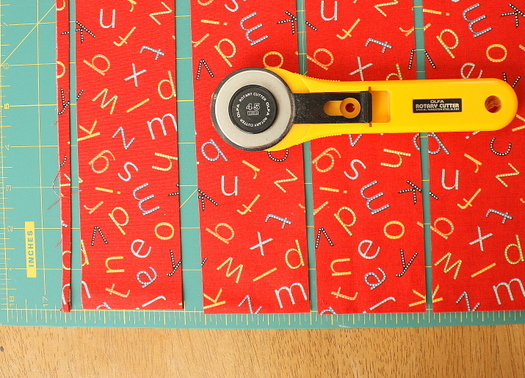
Rotary cutters have made cutting fabric much more accurate and efficient. I love my rotary cutter. Be careful though – those blades are sharp. Make it a habit to keep the safety cover in position and the cutter hidden away from curious small people.
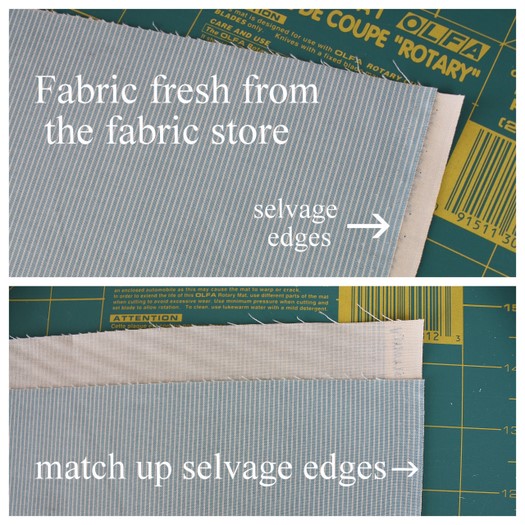
An important – and sometimes over-looked – aspect of cutting fabric is squaring-up the fabric edges before you start hacking-off strips or squares. Sometimes the fabric is wound funny on the bolt or the busy fabric-store worker may just randomly hack off your yardage. Above is a piece that I brought home from the fabric shop. When I stopped to match-up the selvage edges I found out how off it was.
Before you start cutting:
- Match-up selvage edges
- Press the fabric. This may include re-pressing the center fold if the fabric was stretched out of place.
- A light mist of spray starch can also keep things crisp and help with accuracy.
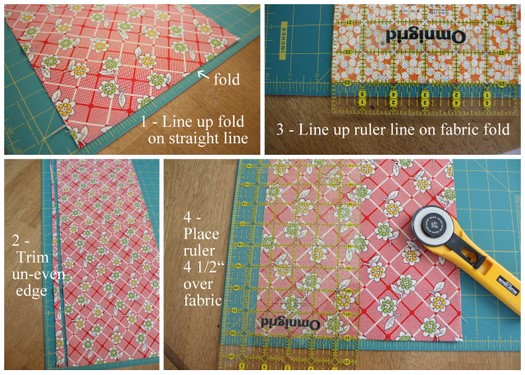
After fabric is pressed and lined-up nicely we want to trim any uneven or frayed edges so we start cutting with a clean, square edge. (Why all the fuss? What happens if we don’t square-up the edges? Your strips will end up in a useless v-shape instead of a straight line.)
- 1- Line up center fold with a straight line on the cutting mat
- 2- Use rotary cutter to trim off the uneven edge
- 3- Line up a straight line on the ruler with folded edge to make sure your strip is square
- 4- Now you’re ready to cut your first strip at the desired width. Whenever possible, use your ruler (not the grid on the mat) to measure the width of the strip. Place the ruler over the fabric at the desired width.
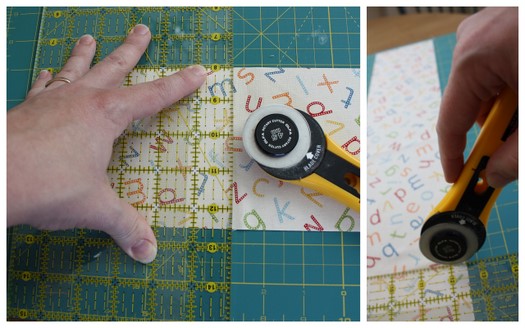
When using the ruler and rotary cutter, hold the ruler in place with a wide, steady hand. Make sure your finger is not hanging over the edge of the ruler. (Trust me on this one. Blood on nice fabric is not pretty.) Cutting while standing will give you more control.
There are other helps to keep your ruler from sliding around. The Notions department at the fabric store sells little sandpaper dots you can stick on the back of your ruler. I use Nexcare Flexible Clear Tape on the bottom of my ruler. I like it because it’s cheap and clear.
Grip the rotary cutter firmly and push it away from your body like a pizza cutter. Be sure to put pressure on the cutter so that it goes through all layers of fabric and keep the blade right next to the edge of the ruler. (The above demo is obviously for right handed folks. Reverse the image if you are left handed.)
If all this seems like a lot to keep track of, remember, the more you do it, the faster it will get and the more it will become automatic. But don’t be afraid to take it slow at first and remember the old carpenter’s rule: measure twice, cut once. Double check your ruler before you start slicing!
For our Quilt Along project, we are going to need these cut pieces:
- 81 – 4 ½” (4″ finished) squares. You should be able to get 9 squares out of 1/8th yard. (Or 64 5″ squares if you are using a Charm Pack.)
- 4 – 3 ½” strips for border fabric.
- 4 – 2 ½” strips for binding fabric. (see photo at the top.)
Up next Tuesday in our Quilt Along Series: Piecing Squares
 Amy Smart is a wife and mom. During her spare time she likes to cut up fabric into small pieces and sew them back together. She blogs about her fabric addiction at Diary of a Quilter. She also likes to do lots of other things that she doesn’t blog about like: watch Masterpiece Theater, eat homegrown tomatoes, and wear flip-flops.
Amy Smart is a wife and mom. During her spare time she likes to cut up fabric into small pieces and sew them back together. She blogs about her fabric addiction at Diary of a Quilter. She also likes to do lots of other things that she doesn’t blog about like: watch Masterpiece Theater, eat homegrown tomatoes, and wear flip-flops.
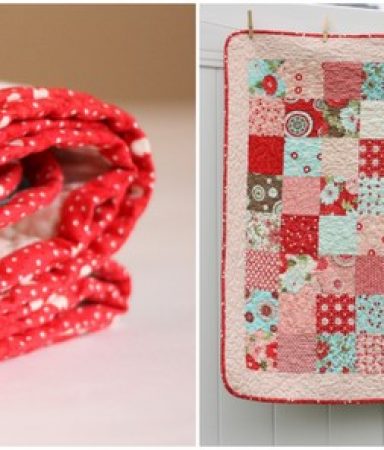
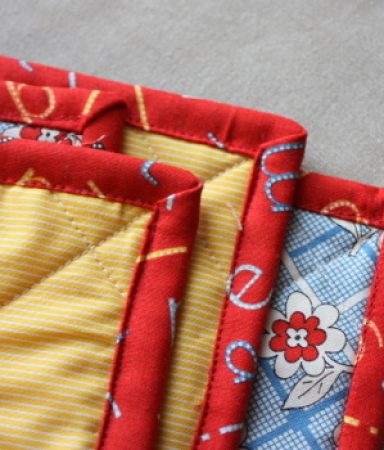
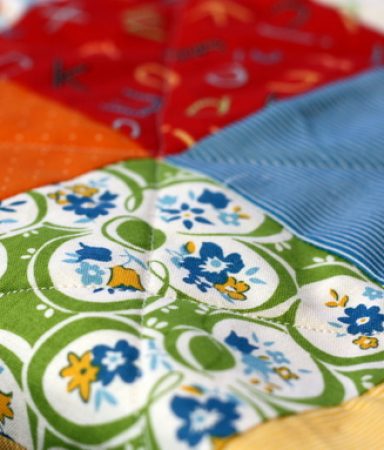
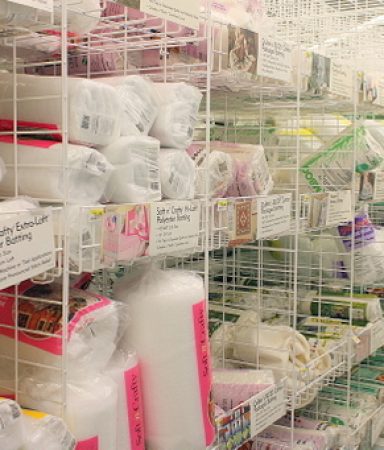


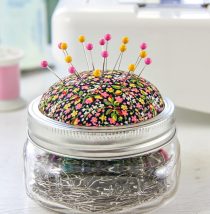

I registered to take a beginners quilting class and I am worried that its not a beginners class. I have called them to ask questions about things I dont understand and have not heard anything back. I wanted to start making quilts. I am a beginner on this. So I was hoping you could answer my questions? What is the grain of the material? How do you find it? Why do you have to cut with the grain of the material? If you dont cut with the grain is it going to really make a difference? I hope that you can help me with this problem because I haven’t been able to find anyone else to help.
Thank you for you help.
Sincerely yours,
Kim
Thank you Amy, this was very helpful. After a few nasty nicks with the rotary blades, I found a safer version with a cover for the upper part of the blade. This one from Fiskars saves me from cuts and I feel comfortable letting my 4-H sewing group use it as well.
I’ve had a couple of questions about border and binding fabric so I thought I’d clarify here in case other people have the same questions.
I am using different fabrics for my border and binding (in my case yellow pin stripe for borders and red alphabet print for binding), but you could use the same fabrics if you want. For this quilt I would go with a smaller print or solid for borders to frame the patchwork part of the quilt -especially if the squares are busy. Also keep in mind that the border fabric will become the dominant color of the quilt so go with the color you like best.
Finally I forgot to mention pre-washing fabric. If you’re using the high-quality quilting cottons, I wouldn’t worry about pre-washing unless they’re red or black. I never pre-wash pre-cut Charm packs. If you’re using something from the bigger-box fabric stores, I would prewash. You can read more about pre-washing here: http://www.diaryofaquilter.com/2010/09/beginner-fabric-shopping-advice.html
Don’t hesitate to email with more questions: [email protected]
Thanks for all the additional great rotary cutting tips!
Sometimes it’s the basics that we need to know about before we go jumping into projects and realize we messed up. Thanks for starting us off with the most fundamental lessons.
ArtL8dy at e14studio
Great tute! Thanks for sharing! One tip I always tell my students is to make sure to start cutting about 1/8″ before the fabric fold to make sure you get those first few threads. Otherwise they go to pull off the strip thinking it’s been cut all the way through and it’s not. We tend to place the rotary cutting blade right where the fabric starts but without the pressure and rotation it won’t cut through. We all know it’s a beast to try to re-align everything back up to cut it again.
A handy tip I was told years ago, to help keep the ruler from sliding, is to place the ‘pinky’ finger of the hand holding the ruler on the fabric rather than on the plastic ruler. Also, to press downward on the rotary cutter, keeping it gently alongside the straightedge not pressing it towards the edge causing it to slide/move.
Mary is right! LOL I nursed a nasty rotary cut for a while. I was tired, laid it down without closing the safety cover and when I went to do something else, I hit it pretty hard with my knuckle. Ouchie! I thought it was never going to heal!
I am nursing a pretty serious rotary cut right now. It happened yesterday and today when I was walking to pick up my son from school it popped open as one of my younger ones was “kissing it to make it better”. I was really tired yesterday so another tip is don’t get behind the (rotary) wheel when you are tired!
Ooooo, we’re getting closer! Thanks, Amy, for such great tips on cutting!
I’m so excited to finally be cutting into this fabric I got last week. YAY!!!!